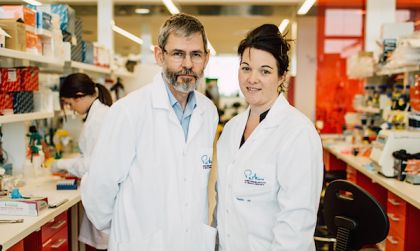
A team of Perth geneticists has helped solve an international search for the cause of a rare muscle disease, jointly leading a publication in Nature Communications describing this disease Myoglobinopathy, caused by a mutation in the myoglobin gene
Research involving teams in Perth, Spain and Sweden identified the genetic mutation for the late-onset muscle weakening disease.
Professor Nigel Laing AO, Head of the Neurogenetic Disease Laboratory at the Harry Perkins Institute of Medical Research and his team, together with the Institute’s Head of Systems Biology and Genomics, Professor Alistair Forrest and his team, analysed genetic material to enable the cross referencing of data from patients presenting with the disease.
“The late onset muscle disease causes muscle weakness and difficulty walking from about age 40, with wheelchair dependency occurring around 15 years later. It can also cause heart failure and breathing difficulties. We don’t know how many people around the world suffer from Myoglobinopathy, but now the genetic mutation has been identified it will be possible to test for it.
“This hunt for the cause of Myoglobinopathy began in Spain with one of the world’s leading neuropathologists, Prof Montse Olivé, analysing the muscles of a family who were presenting with the same muscle pathology of a family she had seen nine years earlier.
“The match meant DNA from two unrelated families could be genetically compared,” said Professor Laing, who has a genetic muscle disease in his name, Laing distal myopathy.
“This is the first time that a disease caused by a mutation of the myoglobin gene has been identified,” says Montse Olivé.
The Harry Perkins Institute team was brought into the investigation because of its reputation for finding the genetic causes of rare muscle diseases.
“We analysed the DNA of those two families and we found exactly the same mutation in their myoglobin gene.”
Myoglobin is the protein that holds onto oxygen in our muscles and heart and releases it when it’s needed during movement and exercise. It is also the protein responsible for the red colour of muscles.
One of the lead researchers on the project, Dr Gina Ravenscroft, said the discovery felt like a Eureka moment.
“We examined a list of muscle genes and cross-referenced it against previously unsolved disease data sets and an anomaly was flagged with the myoglobin gene in three samples. We looked at the samples and discovered they were two siblings and one unrelated person, all with the same symptoms. That was a Eureka moment for us,” Dr Ravenscroft said.
Professor Olivé then suggested the two Spanish families might have the same condition as a large family described in 1980 by Swedish researchers.
The team contacted the Swedish researchers who confirmed there was a genetic match.
Further study by experts in Italy, Austria and Associate Professor Livia Hool’s team at The University of Western Australia indicate the mutation causes the production of toxic oxygen species which may be the mechanism of the disease.
“This work is all part of completing the jigsaw puzzle of the genetics of muscle diseases,” said Professor Laing.
The research was published in ‘Nature Communications’ on 27th March 2019.
